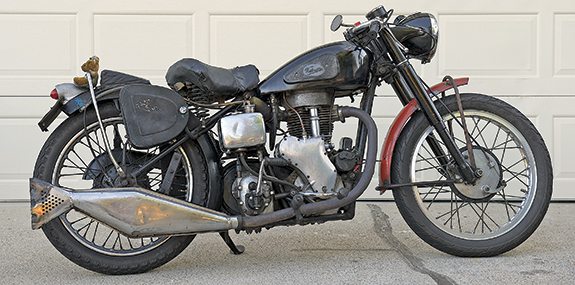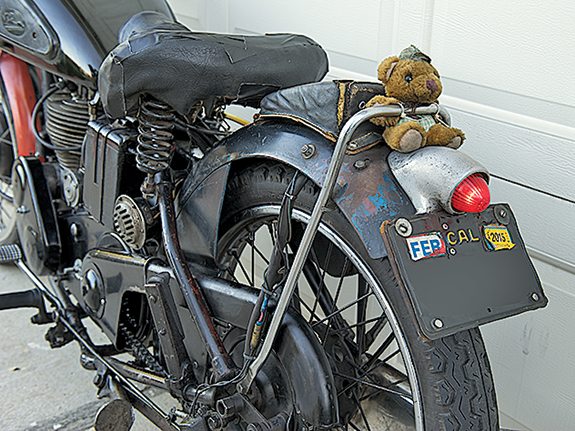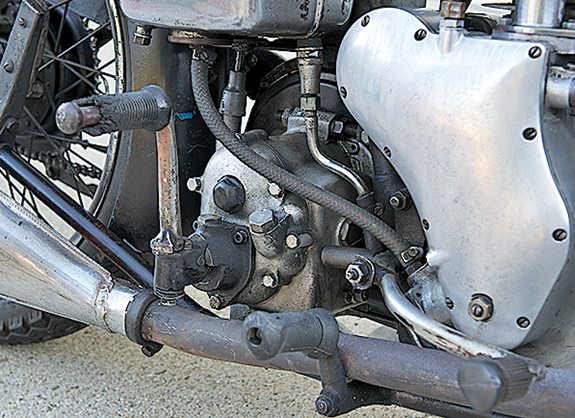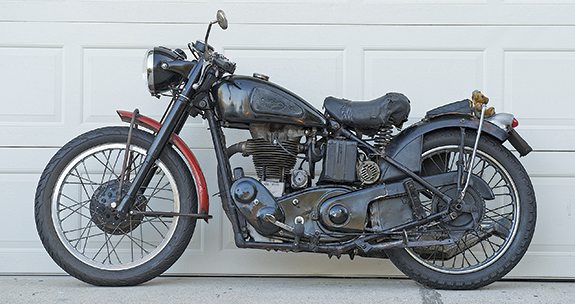The reader may be surprised that this motorcycle is not in more immaculate condition, having a shabby saddle, abbreviated aluminum front fender, chromed oil reservoir and a bunch of other blemishes. Truth be told, around here we are not much interested in concours machines, motorcycles to be found on mantelpieces, but are more amenable to what we loosely call “riders.” Well, this baby has been ridden since 1952—and shows it.

Sometimes beat-up machines are called “rat bikes” or “junkers,” but in the aristocratic world of aged British iron, such motorcycles are usually referred to as “crocks.” And this bike definitely qualifies as a crock; it is reliable, runs well, and often sees the open road. In its day, the MAC was the standard utilitarian English single-cylinder transportation, carrying thousands of men to work every morning and back home in the evening.
The Velo was a cut above the average thumper, the company being proud of its racing heritage and wanting to let the potential customer know that this 350 was a very capable ride. It cost a bit more than the equivalent BSA or Matchless 350s, but the rider knew that he had something a bit special.

Veloce Ltd. started building motorcycles back in 1905, functional two-strokes, but John Goodman and his two sons were more interested in the romance of competition. In 1924 they began selling the first of the K series, overhead camshaft singles, one of which won the Isle of Man TT in 1926. These lively thumpers were much desired in a flourishing economy, but when the stock market crashed in 1929, so did the market for sporty machines.
The MAC story begins in 1933, the depths of the Depression, after Velocette realized that the K bikes were just too pricey for most hard-working souls who were neither going to get promoted, nor see an increase in pay. The Goodmans had hired an engineer named Charles Udall back in the late 1920s, and he was assigned the task of making sure that Velocette’s bottom line stayed in the black.

A new OHV 250 single was introduced, the MOV, having an almost square cylinder with a camshaft placed high up in the crankcase. The high cam allowed for shorter pushrods, which meant more revs were possible; 5,000 rpm for a 250 single back in ’33 was considered exceptional. Also, these valve springs were covered; at the time it was considered essential to have the mechanism open to cooling air, but Udall felt that was unnecessary, and enclosing the head would mean better lubrication and no exposure to road dirt.
In 1934, the engine was stroked to 349cc and the MAC was born…which would stay pretty much the same for the next quarter century. A magneto sat behind the cylinder, a belt-driven dynamo (generator) in front. So as not to waste power turning the generator, the belt could easily be slacked off when riding during the day.

The dry sump had the oil in a reservoir on the right side of the rider’s saddle. Udall appreciated that good lubrication meant longer engine life, and made sure that lots of oil went to many places—including the cylinder walls to reduce the risk of seizure. This engine had narrow crankcases, allowing it to sit low in a cradle frame, enhancing the handling. The rear was rigid, standard for the time, with a Webb-designed girder fork up front.
The single-row primary chain ran to a 4-speed gearbox—using a new positive-stop foot-shift mechanism. One curiosity was that the clutch was tucked in between the primary sprocket and the sprocket for the final-drive chain, which did serve to limit the number of plates in the clutch. The bike also had the classic Velocette fishtail muffler, a design that stayed in the line until the factory closed.

In 1940, Nazi planes began dropping bombs on Britain, and Velocette turned to making the 350cc motorcycles for the war department, designated MAF. The Germans were vanquished in the spring of 1945, and the factory got back into the business of pleasing civilians, essentially repainting the MAF. The MAC was a good seller in a country that craved private transportation; it could even haul a sidecar.
No substantive changes were made until the Webb people went out of business in 1948, and Velocette bought new “Oleomatic” forks from the Dowty company, an early try at air/oil-controlled telescoping forks. That did not go well and Velocette developed its own more conventional design, first seen on the ’51 MAC, with the springs buffered by the oil content.

Here we have the last of the rigid-frame MAC Velos, a 1952 model, with traditional 19-inch wheels fore and aft incorporating skinny 7-inch brakes and a 2.5-gallon tank. Compression ratio on the post-war low-octane gas was a mere 6:1. Curb weight is around 320 pounds. Horsepower? Around 17. Top speed? Seventy-five or so.
The next year, ’53, an entirely new swingarm frame was introduced, with a pair of shock absorbers fit into 10-inch sliders on each side of the fender. This “Arcuate” system had no preload adjustment in the shocks; one loosened the top bolts and slid/compressed the shocks into the desired load setting instead.
Then the sports version of the 350, called the Viper, came along in 1956, with a much-altered engine and a compression ratio as high as 9:1 stock; that engine could rev to more than 7,000 rpm. The market for practical motorcycles was vanishing, and the trusty MAC disappeared after 1960; the Viper stayed on until the end in 1971.
Should you be at a Brit-bike rally and see this mellow Velo crock rolling along, say hello to Tim.
(This Retrospective article was published in the April 2015 issue of Rider magazine.)








great !! the MAC lovely motorcycle !
As long it’s enjoyed it does matter what other people think